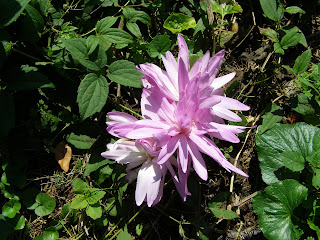

CLICK ONCE OR TWICE ON THE PHOTOS TO ENLARGE THEM.)
I think this species of
Cimicifuga is
ramosa (but I suppose it could be
racemosa). I have both in my yard. The earlier flowering species smells absolutely wonderful. This later flowering species looks nicer - possibly.
Hunden og Hunderacerne (The Dog and Dog Breeds), Copenhagen, 1887, Viggo Moeller
"The Iceland Dog resembles the Greenland Dog, but is smaller, more slenderly built and more long-legged. It is somewhat under medium size, being only 10 1/4 - 15 1/2 inches tall, and if anything should be described as small.
The head is comparatively large, with a broad, high-domed skull, rather pointed muzzle and tight lips. The ears are large, broad at the base, pointed (triangular) and upright. The eyes are small, round and dark in color. Head and neck are carried high.
The body is lightly built, with a comparatively short back, broad in front, deep chest. Belly drawn up. Legs slender, well set and well shaped.The foot is long with small, curved claws. The bushy tail is carried curled up over the back.
The coat is of medium length, longest on the haunches, the tail and the underside of the belly, and it lies close to the body. On the muzzle and legs it is short, and there is no plumed fringe on the front legs.
The colour is commonly brownish or greyish and dirty white or yellowish. A usual colour distribution is: back black, underside of the body and limbs white, with the latter colour also on the underside of the tail and its tip, and as a collar around the throat. Dr. Krabbe has obtained a couple of stuffed specimens of this type for the museum of the Royal Veterinary and Agricultural High School of Denmark."
(From
The Iceland Dog 874 - 1956, Mark Watson )
Wouldn't it be absolutely amazing if one or both of those stuffed dogs still existed in Denmark and they could be compared to modern animals?
= = = = = = =
Vore Hunde (Our Dogs), Copenhagen, 1900, Eugen Colding
"The Breed. - - - Its fur is thickly padded with wool, which can be combed off in tufts when it sheds. Its coat is true fur, in other words; it has glossy long hairs, and it slightly resembles the bear. The colour is most frequently white, yellow-white, spotted brown, more rarely black. I have only once seen a true black type in Iceland. The forepart of the body is surprisingly developed in proportion to the hind part of the body, which is slight and slim. - - - - - The Icelandic Sheepdog has pronounced webbing between the toes (and it swims across violent glacier rivers in a fascinating manner).
The head is taperingly wedge-shaped, even more wedge-shaped than that of the Greenland Dog, where the lines of the head are marred by the too heavy jaws and masticatory muscles. The eyes are large, intelligent and exceedingly lively. It is a characteristic of this dog, as of all mountain dogs, that it sees and hears remarkably well, while its sense of smell is less well developed than that of dogs of the plains.
The ears - well, here we come to one of the most easily recognizable racial characteristics - should be capable of being completely pricked, not a single millimetre of the outer edge of the pointed ear may remain hanging when the animal listens, as it does practically all the time when out of doors; then the cone-shaped, finely haired ears are pricked up straight like those of a horse. The great majority of dogs in Iceland have the tip of the ear bent over when their 'ears are pricked up', thereby at once proclaiming themselves to be mongrels.
In the true type animals the wedge-shaped head gradually merges into the handsome, broad and shaggy mane that bristles out to the sides and down across the chest like a bear's mask. Already directly behind the ears it bristles like a sort of clerical ruff (Lutheran) when the animal bends its head. From the shoulders the stocky body tapers both in breadth and height, and, as stated before, the haunches are strikingly small. The tail should be very bushy and stand permanently curled up over the back like a watch-spring, and the hairs should form a sort of parting under the upturned tip of the tail.
In Iceland, the true Iceland Dog is distinguished from the mongrel by its ears, mane and tail.
A thick growth of hair covers the anus - another charm of this animal. On each front leg it has a small spur, on each hind leg a well developed double spur."
The author (Eugen Colding) goes on to talk about the temperament, intelligence, hardiness, behavior, etc. which is extremely interesting and fits perfectly with what we all know. He named his own dog Saumur after the dog in an Icelandic saga.
(From
The Iceland Dog 874 - 1956, Mark Watson )
= = = = = = =
In the Danish Kennel Club Catalog from 1900 there are three Iceland "Spitz" dogs listed all bred by the owner, Sergeant Lindholm, Aalborg, Denmark.
137. Thor - 1899. Black with white markings out of Svartur bred with Pillar
138. Bjoern - 1899. Black with white markings out of Svartur bred with Pillar
139. Freja - 1899. Black with white markings out of Svartur bred with Pillar
(From
The Iceland Dog 874 - 1956, Mark Watson )









































